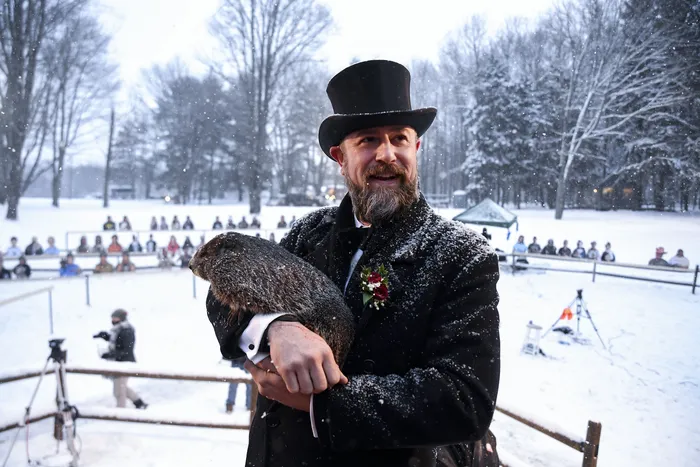Groundhog Day: The slightly odd yet faithfully celebrated holiday with a fascinating history
AJ Dereume, groundhog handler, holds Punxsutawney Phil at Gobbler’s Knob on Groundhog Day. Phil predicted six more weeks of winter again this year. Photo credit Barry Reeger, AP, via The Philadelphia Inquirer.
A near-record crowd of thousands – with many more watching the livestream from home – gather in the early dawn hours at Gobbler’s Knob, eagerly awaiting a verdict for the next six weeks of 2022: an early spring, or more winter?
Shortly after seven o’clock, America’s favorite groundhog stuck with his not-so-trusty prediction yet again last week, forecasting another six weeks of winter after spotting his shadow. Since the first celebration of Groundhog Day in the late 1800s, Punxsutawney Phil has predicted six more weeks of winter 85% of the time, but with only a 40% accuracy rate.
Although he’s probably the most famous, Phil isn’t the only weather-prognosticating marmot, and he’s certainly not the most reliable. A few hundred miles away, New York’s Staten Island Chuck has upheld an 85% accuracy rate in his years of predicting. Chuck contradicted Phil again this year, forecasting an early spring for the country.
Milltown Mel reportedly had a near-perfect run during his seven years as a marmot meteorologist. Unfortunately, New Jersey’s beloved groundhog died unexpectedly a few days before February 2 this year, leaving his fans without a local replacement for the big day.
Milltown wasn’t the only town left hanging by their residential woodchuck this year: Alabama’s Birmingham Bill slept through the festivities. Groundhogs naturally hibernate through the winter, usually waking up in early February to find a mate, then going back to sleep for another month. Bill didn’t wake up in time again this year, and his handlers decided to let him sleep. In previous instances of this, Bill’s duties have been filled by Bilbo the owl and Jill the opossum.
Despite the various cities and groundhogs across the US that are in the spotlight on February 2, Gobbler’s Knob, just outside the borough of Punxsutawney, Pennsylvania, is the most popular. It’s the original location of American Groundhog Day celebrations, but it’s not exactly the origin of the tradition itself.
February 2 is also the date of a Roman Catholic holiday called Candlemas. There are a few religious historical events celebrated on this day, but it’s also the day candles are blessed, which is closer to the root of Groundhog Day.
Superstitions held that the weather on Candlemas would be representative of the weather to come. There are several verses expressing this idea, such as the one that follows:
“If Candlemas Day be fair and bright
Winter will have another fight.
If Candlemas Day brings cloud and rain,
Winter won’t come again.”
Germans were one group that subscribed to this superstition, but they actually used hedgehogs as their indicators instead of just that day’s weather. When Germans came to the Americas, they started using groundhogs instead of hedgehogs to continue their weather predictions – hedgehogs are not commonly found in Pennsylvania, where they settled, but groundhogs are. The first Groundhog Day was celebrated in 1887 at Gobbler’s Knob, which remains the token location for the annual forecasts.
They might not be the most accurate or conventional form of meteorology, but Groundhog Day predictions are certainly a favored and long-established tradition.
Your donation will support the student journalists of Loudoun County High School. Your contribution will allow us to purchase equipment and continue to print our issues for the students at our school.

Evelyn Kuzminski is a senior at Loudoun County High School. In addition to two years as the layout editor and a staff writer, she serves this year as an...























